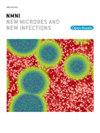Airport/seaport and autochthonous malaria in Europe from 1969 to 2022: A systematic review
IF 5.4
Q2 INFECTIOUS DISEASES
引用次数: 0
Abstract
Background
In the context of this paper, airport/seaport malaria denotes the accidental relocation by air or sea of a malaria infected mosquito to Europe, a non-endemic area, the survival of the transported mosquito and subsequent blood meal and infection of a local person. Autochthonous malaria refers to locally transmitted cases of malaria in Europe.
Methods
The systematic review followed PRISMA guidelines and was registered on PROSPERO (CRD42023444243). PubMed and Ovid MEDLINE electronic databases as well as EMBASE, Scopus and CINAHL were searched for eligible papers. The selection process followed strict inclusion and exclusion criteria.
Results
We included 68 papers describing 115 cases of airport, seaport or autochthonous malaria in Europe, with a total of 68 airport/seaport malaria cases and 47 autochthonous malaria cases. France, Germany, Italy and Spain reported both types of malaria cases. Cases of airport/seaport malaria only were reported from Belgium, Luxembourg, Switzerland and the United Kingdom. Cases of autochthonous malaria only were reported from Greece, Malta and the Netherlands. The case fatality rates for airport/seaport malaria were 13.24 % and for autochthonous malaria 2.13 % respectively.
Conclusion
The importance of airport/seaport and autochthonous malaria is related to the frequently delayed or missed diagnosis, leading to high case fatality rates. Rising temperature may facilitate the importation and proliferation of competent Anopheles vectors. Increased human migration and travel with malaria parasite carriage may contribute to the reemergence of autochthonous malaria in Europe.
1969 - 2022年欧洲机场/海港和本地疟疾:系统回顾
在本文中,机场/海港疟疾是指一只感染疟疾的蚊子通过空中或海上意外转移到欧洲这个非流行地区,被转移的蚊子存活并随后吸血并感染当地人。本地疟疾是指欧洲本地传播的疟疾病例。方法系统评价遵循PRISMA指南,在PROSPERO注册(CRD42023444243)。检索PubMed和Ovid MEDLINE电子数据库以及EMBASE、Scopus和CINAHL。选择过程遵循严格的纳入和排除标准。结果共收录欧洲机场、海港和本地疟疾病例115例,共68例,本地疟疾47例。法国、德国、意大利和西班牙报告了这两种类型的疟疾病例。仅比利时、卢森堡、瑞士和联合王国报告了机场/海港疟疾病例。只有希腊、马耳他和荷兰报告了本地疟疾病例。机场/海港疟疾病死率为13.24%,本地疟疾病死率为2.13%。结论机场/海港和本地疟疾的重要性与延误或漏诊频繁,导致病死率高有关。气温上升可能促进有能力的按蚊媒介的输入和增殖。携带疟疾寄生虫的人类迁徙和旅行的增加可能导致欧洲本土疟疾的重新出现。
本文章由计算机程序翻译,如有差异,请以英文原文为准。
求助全文
约1分钟内获得全文
求助全文
来源期刊

New Microbes and New Infections
Medicine-Infectious Diseases
CiteScore
10.00
自引率
2.50%
发文量
91
审稿时长
114 days
 求助内容:
求助内容: 应助结果提醒方式:
应助结果提醒方式:


